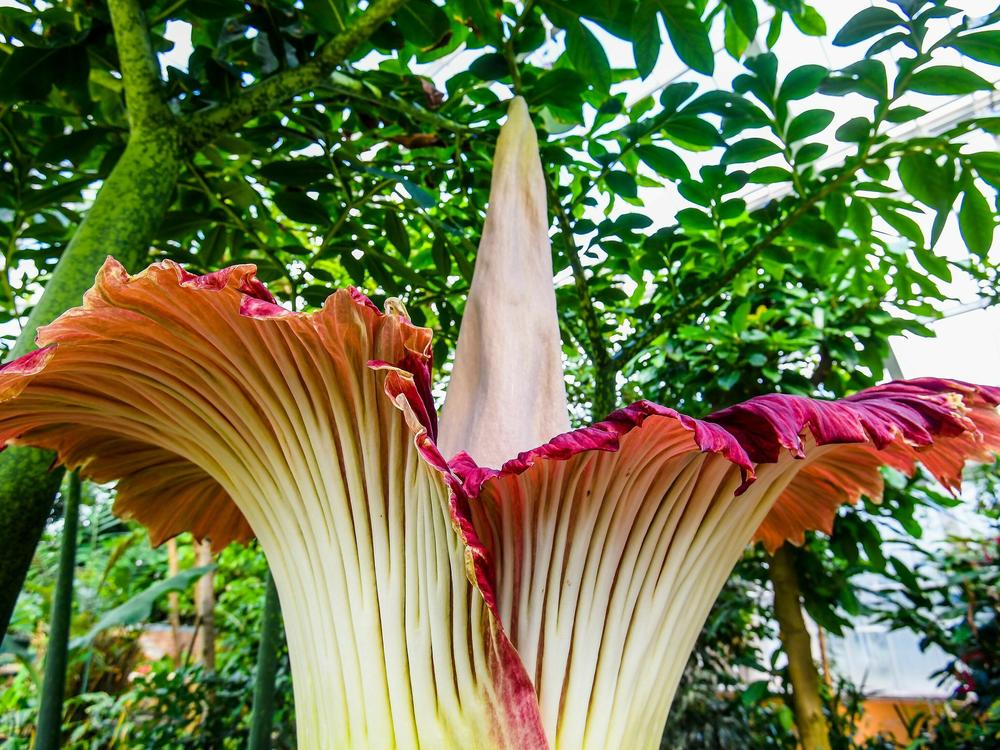Section Branding
Header Content
Unspeakably stinky and unpredictable: two corpse flowers are blooming in the U.S.
Primary Content
The Titan Arum, or corpse flower, has become a rockstar in the plant world for its unpredictable displays, and more notoriously, its putrid stench of rotting flesh.
What is it? The very large flowering plant is related to the calla lily, and in fact looks like a supersized and more macabre version, with a large central spike surrounded by a frilly maroon skirt of a leaf.
- The Titan Arum is native only to the Indonesian island of Sumatra, but has become even more difficult to see in the wild due to habitat loss. In the last few decades, advances in technology and horticultural knowledge have allowed botanical gardens to cultivate the corpse flower more widely.
- If you're not familiar with why the flower has its distinctive name – when the corpse flower unfurls, tiny male and female flowers at the base of its large central spike emit a putrid odor, akin to rotting meat and stinky laundry.
- Titan Arums have a fairly long and unpredictable flowering cycle, and they can take up to a decade before they flower for the first time. Even mature plants can go years between blooms. Essentially, they work on their own schedules – which is part of the excitement for viewers.
What's the big deal? Right now, two corpse flowers are blooming in California.
- One is at San Francisco's Conservatory of Flowers, while the other is at the San Diego Botanic Gardens.
- The Conservatory's corpse flower is named Scarlet, and last bloomed in 2019. She began blooming again earlier this week, and is still standing tall for her many visitors in San Francisco's Golden Gate Park.
- San Diego's flower du jour last bloomed in 2021, and is already noticeably more shriveled than the peak event earlier this week. That's because corpse flower blooms are brief, shining, stinky moments in time, typically lasting just a couple days.
What are people saying? Ari Novy, president and CEO at the San Diego Botanic Garden, spoke to NPR's Daniel Estrin about witnessing the symphony of stench in real time.
His own description of the corpse flower's perfume:
The way I describe it is it smells like if you took your teenager's dirty laundry and you put it in a big black garbage bag, and then you added in some hamburger meat, maybe some fish, a little garlic and some parmesan cheese. And you left that by the side of the road on a very hot desert day for about 24 hours. And then you came back to it. That's not even exaggerating. That is really what the smell was.
On why the corpse flower has evolved to smell this rank:
There are insects out there that really like the smell of rotting flesh or other fetid or rotting odors. And those insects can pollinate plants. There are several plants that utilize this strategy of using rotting flesh odors that humans find repulsive to attract a bunch of insects who actually love that smell.
On the public reaction to the bloom:
This is like the rock star plant of the plant world. It's kind of like a panda if you were in a zoo. It's amazing, people come from all over the place. We had one bloom about 18 months ago and a guy saw it on the webcam in Texas and immediately got in his car so that he could make it for the blooming. And he drove day and night and got to San Diego 14 hours later. This plant really brings out people, and for a smell that's so putrid and disgusting for human beings, somehow we're still pretty attracted to it.
Want the full scoop on this stink? Hit the play button at the top of the page.
So, what now?
- If you're local to either establishment and want to catch the tail end of the bloom, you better head out quickly; the flowers will continue to droop from here on out.
- And if you were hoping to catch that signature stench, Novy says better luck next time: "At this point in the blooming cycle, it's done with its formal flowering. The flowers have done their work and so it doesn't have that much of a smell. There's some residual, but the real pungent punch typically comes in the evening, early morning on the first and second nights of flowering."
Learn more:
- Roller coaster riders were trapped upside down for hours after mechanical failure
- Meet Scooter, the winner of this year's World's Ugliest Dog contest
- Octopuses tweak the RNA in their brains to adjust to warmer and cooler waters
Copyright 2023 NPR. To see more, visit https://www.npr.org.

